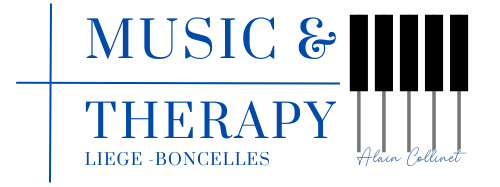Ressources
Ressources
Welcome to these pages dedicated to students and curious enthusiasts! Here you will find answers to some frequently asked questions, as well as several hundred studies categorized by me. I have also included some personal publications or compositions which will be discussed further. This page complements the FAQ page, which is more geared towards the general public.
What is music-therapy ?
There are several definitions that depend on the areas covered by music therapy.
To simplify, music therapy is a therapeutic approach that uses music and its components to improve the physical, mental, and emotional health of individuals. It can be used to treat a wide range of issues, depending on the different intervention areas: psychotherapeutic, medical, psychopedagogical, and psychosocial.
For example, it addresses stress, anxiety, chronic pain, sleep disorders, trauma, mood disorders, communication disorders; it restores learning predictors in dyslexic children; it supports memory efforts in Alzheimer’s patients; it rehabilitates the sequelae of strokes and allows individuals in conflict to externalize emotions. And much more!
During a music therapy session, the music therapist uses a variety of techniques, such as receptive music therapy or listening techniques, active techniques in which the patient produces a creation through instrumental improvisation, movement, and singing. A combined or associated technique further broadens the methods by mixing receptive or active music with another artistic form or another therapeutic form.
The music therapist often works in collaboration with other professionals such as doctors, psychologists, and psychiatrists. Like them, he is a healthcare professional.
Who is the audience I work with?
Adolescents (12-18 years old):
Anxiety, depression, behavioral issues, academic difficulties, family problems, stress management, self-esteem development, academic and career guidance. Young adults (19-25 years old):
Transition to adulthood, relationship difficulties, self-confidence issues, performance anxiety, depression, identity exploration, career guidance, stress management. Mature adults (26 years and older):
Workplace stress, burnout, relationship issues, depression, anxiety, sleep problems, weight management, couple’s issues, parenting, grief, personal development. Pregnant and postpartum women: Prenatal and postnatal depression, parental anxiety, attachment difficulties, breastfeeding support, stress management. LGBTQ+ individuals: Self-affirmation, gender identity management, sexual orientation, discrimination, romantic relationships, family support. Trauma survivors: Post-traumatic stress, depression, anxiety, flashbacks, nightmares, memory issues, EMDR therapy. Individuals with disabilities: Depression, anxiety, self-esteem issues, social isolation, adaptation to disability, management of chronic pain. End-of-life individuals: Psychological support, anxiety and fear of death management, support for loved ones. Eating disorder (ED) treatment: Management of eating disorders such as anorexia nervosa, bulimia nervosa, binge-eating disorder, and other unspecified eating disorders. Support for individuals and their loved ones. While this sector was one of my specialties earlier in my career, I no longer provide child therapy services unless specifically requested by a healthcare professional. If you are seeking a professional to support your child, I would be happy to recommend competent colleagues.
How can it be beneficial for people suffering from stress or sleep disorders?
Let’s take the example of stress. Music therapy can be a very effective tool for managing stress by reducing the level of cortisol, the stress hormone, in the body. Music can also promote relaxation and decrease symptoms of anxiety. Regarding sleep disorders and difficulties falling asleep, for example, they are often multifactorial. Music can act on falling asleep both on the mental level by diverting the patient’s attention from recurring problems and also on the physiology by creating a bodily response to the rhythm of the music. This is where the technique of “slashing” comes into play, which lowers the tempo parameter of the music. The body spontaneously reacts by lowering its own cardiac and respiratory biorhythms. The rhythm becomes conducive to falling asleep.
What are the areas of intervention and their indications?
Here are these sectors, which are sometimes interconnected:
The medical sector: Algology – Sleep disorders – Alzheimer’s/Parkinson’s disease – Palliative care – Perinatology – Rehabilitation (motor-language…), Stroke…
The psychotherapeutic sector: Mood disorders, anxiety, anguish, depression, borderline states…
The psychopedagogical sector: School delays, disabilities, learning difficulties, dyslexia, ADHD…
The psychosocial sector: Social maladjustment, delinquency, prison environment, defendants…
Research: Medical, etc.
Listen to the slash music used by the CHU Liège Interdisciplinary Algology Center.
A new learning leads to a new awareness. G. Ducourneau
“To learn is to have a project, it’s to envision oneself differently in the future.”
Philippe Meirieu
©Alain Collinet 2024
